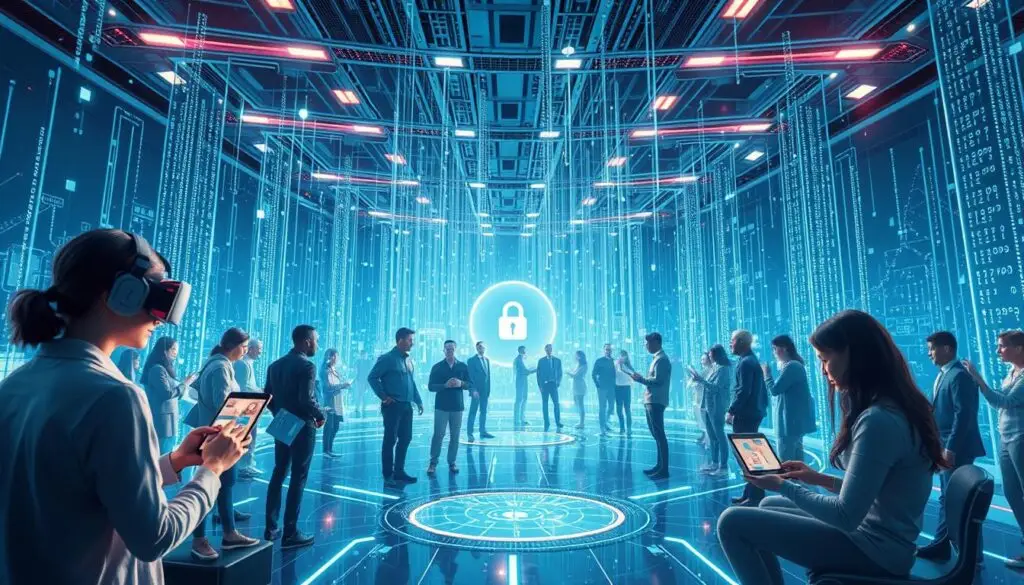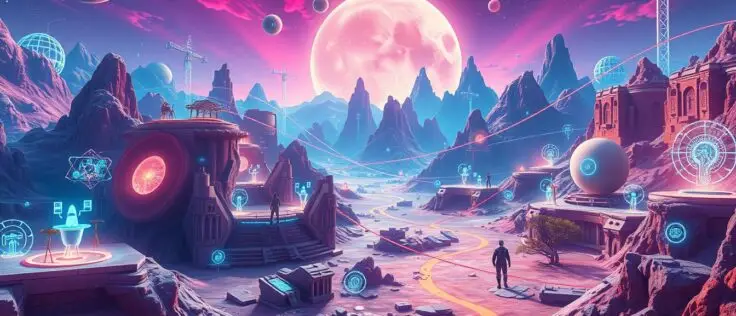What happens when Artificial Intelligence meets Virtual Reality? This mix is changing how we interact with technology. It’s making digital worlds more real than ever. AI boosts this blend by recognising speech, predicting likes, and even diagnosing diseases1. Together, AI, VR, and AR make digital spaces that respond to us in new ways. They make our online experiences more personal and engaging1.
As technology advances, we aim for experiences that feel more natural. AI helps VR systems learn what we might do next, bringing a new level of personal touch2. Natural Language Processing and Computer Vision make chatting and looking around in VR feel real. This makes using technology easier and more lifelike2.
Thanks to AI, VR worlds come alive with smart characters. These characters can think and make choices because of advanced AI like neural networks2. AI in VR isn’t just for studying; it’s improving how we learn communications skills and healthcare. It makes training more effective, from teaching better ways to talk to performing surgeries1. This shows the amazing future for education, healthcare, and more with smart technology.
Exploring the Synergy of AI and VR
AI and VR are coming together, changing how we interact in digital worlds. This blend makes virtual spaces more engaging. With AI’s help, VR experiences are getting better and more interactive. AI characters and VR settings are growing more complex. This mix is attracting people from across the globe.
The Evolution of Artificial Intelligence
AI has grown from simple tasks to today’s advanced deep learning. It now uses NeRF for realistic 3D scenes in VR3. AI-generated voices add human touch to virtual worlds, making them more real3. AI’s growth means it can predict what users will do next. It makes digital interactions feel personal using advanced language skills3.
The Advent of Immersive Virtual Realities
VR’s foundation was built in the mid-20th century. Now, it’s full of opportunities, thanks to AI. Today’s VR changes with AI, based on what the user does. This makes the virtual world feel more real and personal4. AI looks at how people use VR to give everyone a unique experience3. AI and VR together not only make things more interesting but also help areas like education and healthcare by offering new chances for experience.
The Emergence of AI-Powered Virtual Reality
The world of virtual reality (VR) has transformed with artificial intelligence (AI). It has led to big changes in real-time rendering, better simulation accuracy, and the making of interactive worlds. This shift is a big step up from the basic tech of the past to the complex systems we have now.
Enhanced Real-time Rendering via AI
AI has changed how virtual worlds are made in real time. With AI, developers can now build detailed environments that act like the real world5. This makes the visuals more appealing and makes users feel more a part of these worlds. Thanks to advanced machine learning, VR can now show complicated scenes instantly, making everything more real and quick6.
Personalised Experiences through User Engagement
AI learns from how users act to make VR very personal. It changes environments on the fly to meet what each person needs and likes best6. This means everyone gets to have a VR experience that’s just right for them, focusing on their own interests and actions5. This ability to customise is super helpful in areas like education and training. It can make learning more effective and fun.
AI Characters Transforming VR Landscapes
In the world of virtual reality, AI Characters are changing how we experience games and stories. These advanced AI beings respond to players, making each story unique. This creates a deep, rich experience for users.
Architects and designers are using AI to make designing more intuitive. They use AI for gesture recognition, letting them shape their projects with hand movements8. This speeds up the design process and makes it more interactive.
AI characters make learning more personal too. Students can dive into different subjects in a way that adapts to their learning style7. This makes learning fun and effective, moving beyond just looking and listening.
Looking ahead, AI could change how we interact in social VR spaces. Imagine avatars that show complex emotions, making digital interactions feel more real8.
The use of AI in VR isn’t just a tech upgrade. It’s changing the essence of virtual experiences, making them more engaging and useful. We’re entering an era of VR that’s guided by our needs and powered by innovation.
Real-world Applications of AI and VR Convergence
The mix of artificial intelligence (AI) and virtual reality (VR) changes many areas, especially education and healthcare. Together, they make learning and healing more immersive. This is big news for how we gain knowledge and get better.
Revolutionising Education with Interactive Worlds
By bringing AI and VR together in schools, students can get to important info right away, making learning faster9. Augmented reality helps too. It makes hard ideas easier to understand by showing them in real life, which makes learning more engaging.
The Impact on Healthcare: Simulation and Training
In healthcare, AI and VR together create safe training for medical staff. These real-life-like training sessions let them practice without actual risks9. In the next five years, we expect AI to bring even more advances. Like avatars that can understand emotions for therapy and better training sims10. This will make training quicker, better, and cheaper9.
This AI and VR combo is changing how we train and develop skills in many jobs. It’s especially good for teams working remotely9. This blend of technology is not just improving current ways but is creating new, more effective training methods worldwide.
Real-time Translation and Cross-linguistic VR Experiences
AI and virtual reality are changing how we interact with different languages. They do this through real-time translation and cross-linguistic engagement. With technologies like neural machine translation and deep learning, AI can provide translations that grasp the context of languages11. This breakthrough makes VR experiences richer, allowing AI characters to converse in many languages. This promotes diversity and connection in virtual worlds.
Adaptive learning platforms use AI to tailor content for each user. This makes learning more personal11. AI characters help learners by giving instant feedback and starting engaging conversations. In settings like VR business meetings, AI translates speeches on the spot. This cuts down delays and smoothens conversations12.
These AI features also help get past the challenges of distance and language differences. For example, AI can quickly translate Spanish videos to English. This makes VR experiences smoother and extends VR’s global reach12. Looking ahead, video translation in VR and AR is expected to grow. It will create multilingual and interactive spaces that encourage cross-cultural understanding12.
Such progress is turning virtual reality into a space that is truly welcoming and worldwide. Here, real-time translation and AI characters lead the way in understanding multiple languages. These improvements not only widen VR’s uses but also better the communication and interaction within it.
The Role of Extended Reality in Technology Integration
In today’s tech scene, Extended Reality (XR) is changing the game. It blends the real and the digital worlds. By including Virtual Reality (VR), Augmented Reality (AR), and Mixed Reality (MR), XR changes how we see and interact with our surroundings13.
Mixing AR with VR for a Richer Immersion
AR brings digital info to our real world, while VR takes us to fully crafted virtual spaces. Together, they create a deeper mixed reality. This combo doesn’t just deepen our immersion. It also leads to new uses in many areas. For example, in gaming, XR makes playing much more engaging, like in Pokémon GO and VR games13.
How Extended and Mixed Realities Contribute to the Future of VR
Extended and Mixed Realities are shaping VR’s future. They make VR more interactive and blend the real with the virtual. In healthcare, they help with training and therapy by offering lifelike simulations13. Also, XR’s progress relies on advanced cameras and processors. These are vital for headsets and phones in Mixed Reality13.
When XR meets AI, many industries like digital marketing, healthcare, and education, are set for big changes. As XR grows, it brings us closer to a world full of immersive interactions.
Interactive VR Environments: A Leap into Interactive Learning
Interactive VR environments are changing the way we learn. They make simulated classroom settings and VR field trips more exciting. This allows students to explore new ways of learning. Advanced AI in these technologies makes virtual interactions feel real by responding quickly to what we do.
The Power of Simulated Classroom Settings
VR classroom settings take students to immersive spaces. Here, they can see and interact with what they’re learning. This improves understanding and memory. These virtual spaces offer personalized learning based on each student’s needs. AI helps match learning styles, making everything more straightforward.
This approach is also great for students who find movement challenging. It makes learning accessible for everyone15.
Virtual Field Trips: Breaking the Boundaries of Traditional Education
VR field trips are changing how we learn about places and cultures. They let students explore without the need to travel. This method supports discovery and understanding of the world. It encourages curiosity and understanding of others through real experiences. And, these virtual trips are getting better, thanks to AI15.
AI in VR improves how we experience virtual worlds. It makes it easier for everyone to start using VR. It’s key in changing how we teach and learn. By saving costs and removing repetitive tasks, schools can focus on providing better education. AI and VR together change education for the better16.
The future of VR in education looks promising. It aims to develop virtual agents and simulations. These are made for personalized education. They meet different needs for learning. This step moves us toward a future where education is all about interaction, immersion, and new methods16.
Unlocking New Capabilities in Retail with AI-Driven VR
The use of AI-driven VR in shops is changing how we shop and interact. AI helps make VR environments feel real and react to what users do17. This approach creates a shopping trip that feels designed just for you. Now, 67% of shoppers expect brands to use their data for better experiences. AI-driven VR not only meets these expectations but goes beyond them18.
Also, AI-driven personalisation in VR tailors the virtual world to your likes17. This tech helps build a bond and satisfaction, with 65% of shoppers staying loyal to brands that personalise18. AI makes VR adjust on the fly, making the experience smooth and more fun, boosting how much users engage17.
In particular, AI’s use in retail helps with better engagement and personalisation19. This blend boosts customer loyalty and lines up with trends where shoppers favour more personalised services18. The chance for new retail ideas with AI and VR is big. It promises to draw in and keep customers by meeting their changing needs.
This shift in retail suggests a move towards merging digital and real-world shopping. The perks go beyond making customers happy. They could impact the global economy hugely, with AI possibly adding up to $15.7 trillion by 203018. AI-made avatars in media save time and change how stories are told in retail17. It’s a big step towards transforming retail.
Ethical Considerations in the AI and VR Nexus
We’re stepping deeper into tech, and its mix with AI and VR brings big ethical questions. We have to think about how we handle private info, the effects of being in VR too long, and the chances of being tricked. These issues are critical and we can’t ignore them.
To build trust in these virtual spaces, keeping user info safe and having ethical AI is key. We must develop these technologies carefully. They need rules to stop data misuse and keep virtual spaces honest. The way VR might fool or lie to us shows we need strict ethical standards and people accountable for following them.
Also, as more people dive into immersive experiences, we need to talk more about what’s right and wrong. These chats help shape the future of VR. They ensure tech developments make our world better, not worse.
Making sure VR and AI grow in a good way means setting up rules against bad behaviour. As these technologies become part of everything from fun to learning, keeping a strong focus on ethics is important. It helps protect users and makes sure tech improves our lives.
Addressing the Challenges: Privacy, Accessibility, and Beyond
In the digital era, combining AI with VR leads to major progress and big challenges, especially around privacy and data protection. AI-driven VR collects loads of personal info. This includes data on how users act in the virtual world, which reveals things like race and gender. Collecting such data—observable, observed, computed, associated—highlights the need for strong privacy protections20.
AR/VR tech handles a lot of detailed and delicate data. This ranges from biometrics to brain signals. The personal nature of this data calls for clear privacy rules that match current laws, like HIPAA in healthcare. Also, laws specially made for AI and VR’s unique issues are vital. They keep user trust and create a safe digital space20.
The challenge of making AI and VR accessible to everyone is huge. It’s key to avoid creating a new type of digital divide. Tech firms and policymakers play a big role. They should work to make these innovations open to all, fostering an inclusive digital world. Taking early steps in design and policy can unlock AI and VR’s potential to be forces for good21.

The path AI and VR are on is crucial. The choices we make now will shape how they fit into our lives. Focusing on privacy and accessibility leads to a future where AI and VR can truly change sectors in positive ways. With these technologies offering immersive experiences and better interactions, we must govern them wisely to unlock their full promise.
Conclusion
The combination of AI and Virtual Reality marks an exciting turn in tech evolution, impacting the Future of VR. It brings not just a technological leap but a shift towards deep, interactive experiences2223. These AI-driven VR systems can react instantly to what users do and learn from their actions. This means each experience can be tailored to the individual22.
Looking into immersive experiences, AI-driven VR reaches beyond fun and games. It’s pushing progress in areas like healthcare and education2224. These advancements aim to create learning and healing spaces that adjust to how individuals learn and heal, introducing a new era of personalised development2224.
FAQ
How is Artificial Intelligence shaping the future of Virtual Reality?
Artificial Intelligence (AI) is making Virtual Reality (VR) better by making it more like real life and more engaging. AI enables highly detailed and lifelike experiences in VR. These improvements help in training, learning, healthcare, and fun, making them more exciting and useful.
What role do AI characters play in VR environments?
In VR, AI characters bring the virtual world to life. They learn and react in a way that feels real. This makes VR feel more realistic and personal, enhancing stories and simulations.
How are AI and VR transforming educational experiences?
AI and VR are changing education by making learning interactive and tailored to each student. VR puts students in the middle of the subject, adjusting to how fast they learn. This method helps students understand and remember better, and they can visit places without leaving the classroom.
What are the benefits of using AI-Powered VR in healthcare?
AI-powered VR provides a safe space for medical training. Medical professionals can practice without risk, improving their skills and patient care. VR also helps patients manage pain and recover, using soothing simulations.
How does real-time translation improve cross-linguistic engagement in VR?
AI-driven real-time translation in VR removes language obstacles. It lets people from different parts of the world talk easily, making VR more open and friendly for everyone.
What is Extended Reality (XR) and how does it integrate with AI and VR?
Extended Reality (XR) blends the virtual and real worlds using VR, AR, and MR. Together with AI, XR creates more complex and realistic experiences. This mix can change many fields by offering richer, lifelike interactions.
What are some challenges faced with the growing integration of AI and VR?
The growth of AI and VR brings up important concerns. Privacy, easy access for everyone, and sticking to moral values are crucial. We must make AI and VR safe and fair to keep everyone’s trust and avoid a bigger digital gap.
How is AI-driven VR changing the retail industry?
AI-driven VR is reshaping shopping with virtual try-ons, smart recommendations, and 3D product views. This new shopping experience can change what buyers expect and how they buy.
What ethical considerations arise from the integration of AI into VR?
Mixing AI with VR asks tough ethical questions about data safety, agreeing to terms, and avoiding harm in virtual spaces. It’s key to look after the mental health of users and stay truthful. Setting and following ethical rules as this tech grows is critical.
How is technology integration ensuring the accessibility of AI-powered VR?
To prevent a digital divide, making AI-powered VR easy for everyone to get is important. There are moves to make VR gear cheaper, share learning resources, and design software that everyone finds easy to use. This way, more people around the world can enjoy AI-powered VR.
Source Links
- Merging Minds and Machines: The Power of AI in Extended Reality – https://www.linkedin.com/pulse/merging-minds-machines-power-ai-extended-reality-david-cain-e9s7c
- Merging AI and VR: Shaping the Future of Digital Realities – Creative Digital Design & Development – https://www.inventivestudio.co.uk/merging-ai-and-vr-shaping-the-future-of-digital-realities/
- AI and VR Integration: Unlocking the Power of New Possibilities – https://mersus.io/exploring-ai-vr-integration/
- Intersection of AI and VR/AR: Exploring the Synergy – https://medium.com/@wiz-wizdomgr/intersection-of-ai-and-vr-ar-exploring-the-synergy-89dc17820aad
- AI in Virtual Reality – IEEE Digital Reality – https://digitalreality.ieee.org/publications/ai-in-virtual-reality
- The Intersection of AI and Virtual Reality – https://medium.com/@jam.canda/the-intersection-of-ai-and-virtual-reality-0dbf9a757b71
- AI Enhanced Virtual Reality: Redefining Experiences – https://www.signitysolutions.com/tech-insights/ai-enhanced-virtual-reality
- Discover How AI is Transforming Virtual Reality Experiences – https://www.tabsgi.com/discover-how-ai-is-transforming-virtual-reality-experiences/
- How AI is powering up VR training – Immerse.io – https://immerse.io/how-ai-is-powering-up-vr-training/
- The Convergence of AI and Virtual Reality: A Predictive Timeline – https://www.linkedin.com/pulse/convergence-ai-virtual-reality-predictive-timeline-jattin-mfa-02vge
- The AI Revolution: Transforming Language Learning & Translation – Teachflow.AI – https://teachflow.ai/the-ai-revolution-transforming-language-learning-translation/
- Video Translation for VR and AR Experiences – InvoZone – https://invozone.com/blog/video-translation-for-vr-and-ar-experiences/
- Extended Reality: The Future of Immersive Technologies – https://www.onirix.com/extended-reality/
- Frontiers | The Combination of Artificial Intelligence and Extended Reality: A Systematic Review – https://www.frontiersin.org/journals/virtual-reality/articles/10.3389/frvir.2021.721933/full
- The AI Revolution in VR: Predictive Positioning Controllers – 4D – https://4dproducts.co.uk/the-ai-revolution-in-vr-predictive-positioning-controllers/
- The Intersection of Artificial Intelligence & Virtual Reality – https://vrvisiongroup.com/the-intersection-of-vr-and-ai/
- Unlocking the Synergy: How AI Enhances VR Experiences – https://autogpt.net/unlocking-the-synergy-how-ai-enhances-vr-experiences/
- Unlocking retail’s future: how AI networks are revolutionising customer experience – https://www.independent.co.uk/news/business/business-reporter/ai-vr-internet-customer-experience-shopping-b2372414.html
- The Integration of AI and Machine Learning in AR and VR – https://www.linkedin.com/pulse/integration-ai-machine-learning-ar-vr-tarini-prasad-ray-aqktc
- Balancing User Privacy and Innovation in Augmented and Virtual Reality – https://itif.org/publications/2021/03/04/balancing-user-privacy-and-innovation-augmented-and-virtual-reality/
- Artificial Intelligence and Privacy – Issues and Challenges – Office of the Victorian Information Commissioner – https://ovic.vic.gov.au/privacy/resources-for-organisations/artificial-intelligence-and-privacy-issues-and-challenges/
- The Impact of Artificial Intelligence (AI) on Virtual Reality (VR) – https://capsulesight.com/vrglasses/the-impact-of-artificial-intelligence-ai-on-virtual-reality-vr/
- The Power of Generative AI in VR: A Gateway to Innovation – https://www.talespin.com/reading/the-power-of-generative-ai-in-vr-a-gateway-to-innovation
- How Virtual Reality Technology Has Changed Our Lives: An Overview of the Current and Potential Applications and Limitations – https://www.ncbi.nlm.nih.gov/pmc/articles/PMC9517547/






